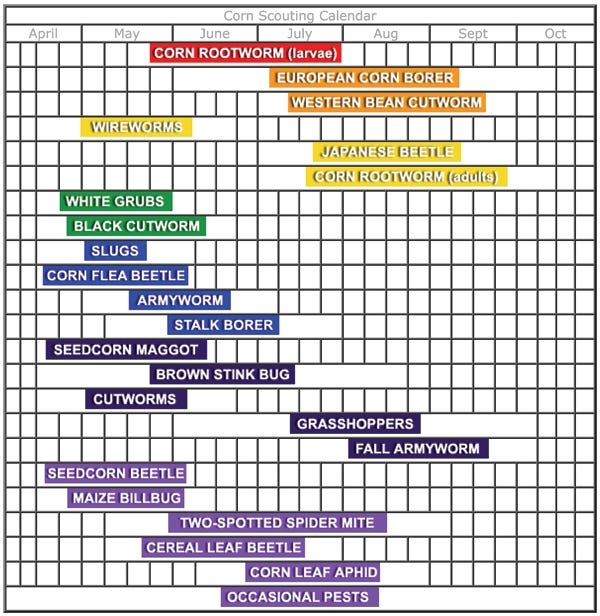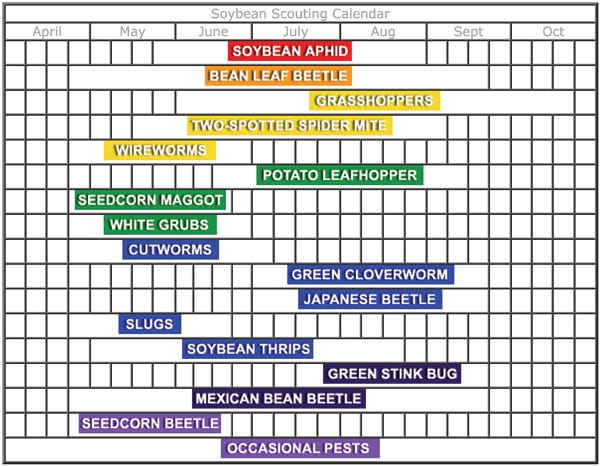
Think DifferentReview scouting recommendations and calendars from your state Extension specialists, field guides and other resources.Establish a crop scouting plan and long-term record keeping for your crops, your fields and your management system.Schedule adequate time to do scouting yourself, contract with a consultant or input supplier or some combination of the three.Review tools from past seasons, update field guides, download PDFs and practice with new tools such as iPads, smartphones, optical sensors or handheld GPS units if you’re not familiar with them.Identify and follow a statistically valid scouting pattern that gets deep into the field and crosses multiple rows.Check with local agronomists and Extension specialists and attend local field days to be aware of developing pest issues and adapt scouting plan accordingly.Always scout first as part of an integrated pest management plan and treat only when needed to protect beneficials and avoid resistance.Evaluate this year’s ROI actions and
March 26, 2013

"There’s nothing about scouting a farmer can't learn," says Bruce Potter, Minnesota Extension integrated pest management specialist. He, along with Ryan Wolf and Harold Watters scout extensively and train growers, crop consultants and agronomists how to scout. Scouting isn't just identifying a disease or insect pest, says Watters, an Ohio State University Extension field agronomist. "It’s also knowing the tools needed and developing an awareness of potential problems."
It is easy to forget things from year to year, adds Wolf, a regional agronomist with Winfield Solutions. Attending field days reminds you “what is going on in the area at a particular time."
Potter starts scouting when seedlings begin to emerge. "The first thing to be aware of is stand establishment," he says. Scouting should also reveal the cause, be it planter problems, pests or disease. However, diagnosis may require more help than a field guide or a smartphone can offer because nothing can be ruled out.
"Wire worms, white grubs and seed corn maggot problems were relatively rare in southern Minnesota even before insecticide seed treatments, and more so now, " Potter says. "However, in spite of advances in seed-applied pesticides, insects and pathogens still occasionally reduce emergence and early season stands."
Like what you're reading? Subscribe to CSD Extra and get the latest news right to your inbox!
Scouting early and often for crop emergence offers a parallel opportunity to scout for weeds and herbicide resistance. Weeds cause more yield loss and added costs than insects, diseases and wildlife, says the Weed Science Society of America.
Weed scouting a lost art
Scouting for weeds is nearly a lost art, Watters says. "When Roundup Ready crops arrived, we threw weed scouting out the window. Some weeds can produce seed in two-weeks. If you miss them, the seed bank is full, and you can have an awful time in years to come.”
Glyphosate-tolerant crops and resistance opened a door for dicamba and 2,4D-tolerant crops – and potential problems as a result, Potter says. With more than 200 weed-resistant species, there is no sure control, making scouting more vital than ever. Resistance puts increased emphasis on pre-emerge herbicides.
"Early evaluation lets you adjust your postemergent herbicides, and later evaluations let you see what worked and what didn't," says Potter. "Live and dead weeds mixed together after an application are a good indicator of resistance.”
With a wider variety of herbicides being used, Potter emphasizes scouting for off-target drift and herbicide injury.
Identification is only the first step; economic thresholds are equally important. "There have been years when we pulled the trigger to protect against aphids too early, killed off the beneficial insects and then had aphids roll in late," Watters says.
Accurate identification and thresholds require more than "drive-by" scouting. Identify a statistically valid pattern in a field and repeat it throughout the season, Watters adds. Apps like Aphid Speed Scout and Western Bean Cutworm Speed Scout from the University of Nebraska-Lincoln, offer detailed scouting and evaluation directions.
However, neither apps nor smartphones are required, assures Watters.
Whether you scout in a W, Z or a circle doesn't matter as much as getting off the same row, out of tillage paths and planter rows to find random situations across the field, he says. "Just use the same pattern each time you scout. It's not a bad idea to use handheld GPS to mark the spots where you stop.”
Effective scouting, patterns
Watters often returns to the same pre-set field spots weekly. He emphasizes getting into the middle of a field, in particular to check for sudden death syndrome in soybeans. As the season progresses, he fans out over four to five rows. In mid- to late-season corn fields, he suggests entering a field, returning to end rows for a distance and then reentering the field and repeating the process.
What to look for and where is also important. Western bean cutworms lay egg masses on upper leaves around tasseling, and grey leaf spot appears on lower leaves about then, Watters says. "The egg masses show up as you look at sunlight passing through the leaves. Use the tools that nature gave you, light and time of day."
Watters emphasizes other tools like a hand lens, soil probe and field guides. He uses the soil probe for checking compaction; the field guide provides ID and threshold recommendations. He uses the Ohio State and Purdue field guides, plus PDFs of online weed and agronomy guides on his smartphone and iPad.
Read about more apps for your smartphone that help your farm operation.
Extension specialists like Watters and Potter have alert networks for neighboring counties, regions or states. Helping growers focus on emerging problems is one of the benefits of field plot programs, says Wolf.
"We hold field days at 30-day intervals in June, July and August and review current 'events' that growers should be looking for over the next 30 days," he says. "We also encourage them to bring questions and samples from their fields to field days. After a brief hiatus in popularity, scouting for rootworm beetles is making a comeback because of western corn rootworm resistance to BT in my area.”
Wolf says Answer Plot attendees were among the first to learn how to identify and count soybean aphids and, more recently, to evaluate hybrid susceptibility to Goss's Wilt.In recent years, corn rootworm trait failure has been a growing concern, with emphasis on identifying economic thresholds of beetles, digging up roots and scoring damage as well as learning how to manage corn rootworm the following year. Field days through the season show growers see how scouting techniques like tissue sampling can help identify nutrient deficiency. Thirty or 60 days later they can see how a foliar application impacted the plot and eventual yield.
Potter emphasizes that it doesn't matter whether growers scout their fields themselves or rely on someone else. The important thing is to scout fields early and often throughout the crop year.
"There are two reasons for scouting. One is to figure out what needs to be done this year or next. The second is to determine if what you did worked, how well and record it. Long-term records of the crop, pest populations and any management practices are vital to prevent economic loss and delay resistance," Potter says.
Scouting isn’t for every farmer; Len Nall, Lake City, Ark., leaves scouting to his crop consultant. With 3,500 acres of corn, 1,500 of soybeans, 6,000 of cotton and 650 acres in beans and rice, he has his hands full without trying to visit fields weekly. Instead, he relies on David Hydrick to scout fields and make recommendations.
"Once we let him know we are planting corn, David starts scouting," says Nall. "David is our go-to-guy on pesticides. He emails his scouting reports with recommendations, and we turn them into application orders. If he's watching for something, he gives us a heads up in the report. If we have problems or questions, we give him a call."
You might also like:
Drought, Flooding, Warm Weather for Spring
Factor Field History, Weather into Crop Disease Management Decisions
3 Pre-Planting Yield Booster Tips
Corn Pest Scouting Calendar
According to Purdue University, these pests with the highest potential for crop damage appear at the top of the calendar within the red bar, while the pests with the lowest damage potential occur at the bottom of the calendar, represented by a violet bar. (Pests and timing may vary by state so check with your area Extension specialist.)

Soybean Pest Scouting Calendar
According to Purdue University, these pests with the highest potential for crop damage appear at the top of the calendar within the red bar, while the pests with the lowest damage potential occur at the bottom of the calendar, represented by a violet bar. (Pests and timing may vary by state so check with your area Extension specialist.)

About the Author(s)
You May Also Like



